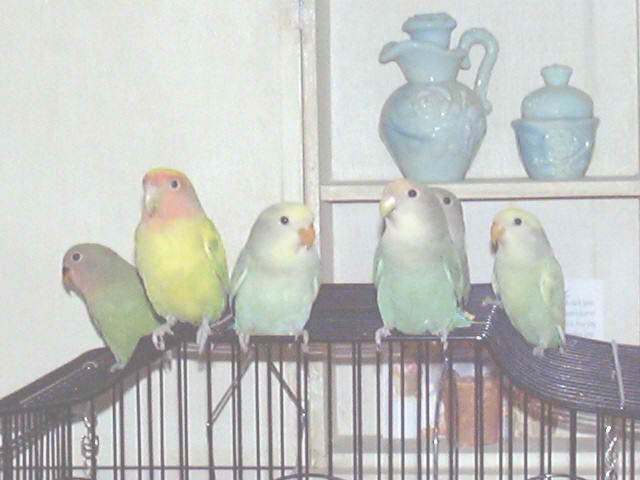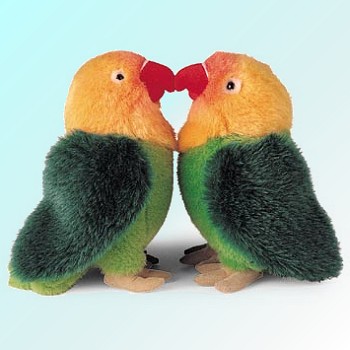Please Help our Pets by Donating One Dollar
A Beginners Guide to Lovebirds
The fascinating behavior of Lovebirds make them among the
most interesting pet bird.
Lovebirds are so named from the way they sit close to each
other, not because they are in love with each other. Lovebirds
can and do mate for life, but it doesn't happen every time.
Lovebirds are social birds and should be kept in pairs.
They are very active and curious birds and can even be quite
aggressive at times. They can chatter all day long with a
sometimes very shrill sound.
Lovebirds are native to Africa and a few nearby islands. In
their native habitat, they are found usually in small flocks
of 10 to 20 pairs.
Lovebirds are of the class Aves, the genus Agapornis and
members of the Psittaciformes, or family of parrots.
Agapornis comes from the Greek words: Agape meaning love,
and ornis meaning bird.
Lovebirds typically live from 10 to 15 years depending a
great deal on the care they are given, some lovebirds have
been known to live to be 20 in captivity.
There are 9 species of lovebirds, of which 8 are available
as pets. They are not related to the South American parrotlets.
Gender Dimorphic
1. Abyssinian Lovebird
2. Redfaced Lovebird
3. Madagascar Lovebird (Grayheaded)
Gender Monomorphic (Similar)
1. Black cheeked Lovebired (Blackfaced)
2. Fischer's Lovebird
3. Masked Lovebird (Black Masked or Yellow collared)
4. Nyasa Lovebird (Lilian's)
5. Peachfaced Lovebird (Rosyfaced)
Characterized by Eye Rings:
Without Eye Rings:
1. Madagascar
2. Redfaced
3. Peachfaced
4. Abyssinian
With Eye Rings
1. Masked
2. Fischers
3. Nyasa
4. Black cheeked
For more info See: Types of Lovebirds

Getting Your Pet Lovebird
What To Look For In A Healthy Lovebird
1. Active, alert and curious disposition
2. 4 well formed toes, 2 forward and 2 backward, nails must
be complete
3. Bright, round eyes
4. Nostrils clear of discharge
5. Feathers lay tight against the body
6. Smooth beak that closes completely
What To Avoid In A Healthy Lovebird
1. A bird that sits huddled in a corner or on the floor
2. A bird with feathers fluffed up
3. Deformed toes
4. Vent fouled with feces or badly stained
5. Signs of weeping or runny eyes
6. Excessive plucking or excessive missing of feathers
7. Bald spots
8. A squeak, wheezing or other abnormality when breathing
9. Nervous behavior
10. Lethargic behavior
11. Dull or lifeless feathers
12. A bird too large for it's normal size (birds can and do
get fat)
13. Nasal discharge
If you are a first time or novice lovebird owner, don't choose
a bird that you think may be sick, choose the healthiest bird
you can find. Many sicknesses can be cured, but better to leave
these birds for experienced owners. Don't buy a sick lovebird
because you feel sorry for it.
If possible get a certificate of health from the breeder or
pet shop guaranteeing that a replacement will be made if the
lovebird becomes sick or won't breed.
Lovebirds are not rare, there are a lot of them around to choose
from. So take your time and select only birds that you really
like the coloring and personality of.
Keeping Lovebirds as Pets
Lovebirds should be kept in pairs, one female and one male. They
very much enjoy each others company, although don't be alarmed
if they have occasional spats with each other. If a pair of
lovebirds constantly fight, then it's best to find each of
them another mate. If you're buying birds from a breeder, make
sure the breeder will exchange birds if they are not compatible.
As a general rule, only one pair of birds should be kept per cage.
Keep one or more cages far enough apart from each other so they
do not allow birds to be able to peck at each other.
When introducing new birds to a home with pre-existing birds,
the new birds may not always be welcomed readily.
See Also:
How Take Care of Lovebirds
Lovebird Behavior
Lovebirds need exercise out of their cages daily.
Remember: Birds Love to Fly
Being cooped up in a cage all the time is not healthy for
them, physically or emotionally. Birds kept in a cage will
often sit on a perch and flap their wings incessantly.
Lovebirds need between 10 to 12 hours of rest a night. Do
not keep your birds in rooms with televisions or other noisy
devices when it's time for the birds to roost. Total darkness
is not advised either, use a small 7 watt bulb in the room
to provide enough night light for the bird to find it's
perch and drink or feed if needed.
Keep all electrical wires, extension cords, etc, completely
hidden and unavailable to the birds.
Never use Kerosene or similar type heaters that give off fumes.
Coal and wood stoves are no nos. No matter how hard you may'
try, a wood burner will emit fumes and smoke into your home
that may kill your lovebird. If you have a home with a wood burner
completely isolate a room only for your birds and use an infrared
or electric heater.
See Also: Bird Safety Tips
for the Home
A fairly constant 80 degrees Fahrenheit temperature is about right
for lovebirds.
It's not a good idea to keep finches, parrots, rosellas, or
budgies with lovebirds
See Also:
Breeding Lovebirds
What to Feed Lovebirds
Totally Adorable Plush Fischers Lovebirds
